Astro Pi: Flight Hardware Tech Specs
Stop! Before you read anything please watch NASA astronaut Reid Wiseman giving us a quick fly-through of the ISS.
In the video you see various computers and screens on the walls and it’s crazy to think that two Raspberry Pis will soon be there alongside them. Even crazier to think that you can get your code running on them!
What would you make them do? A space tamagotchi perhaps?!
So let’s have a look at the flight hardware shall we?
…and here is a picture of everyone’s favourite spaceman, British ESA astronaut Tim Peake, taking a short break from his training to check it out for himself.
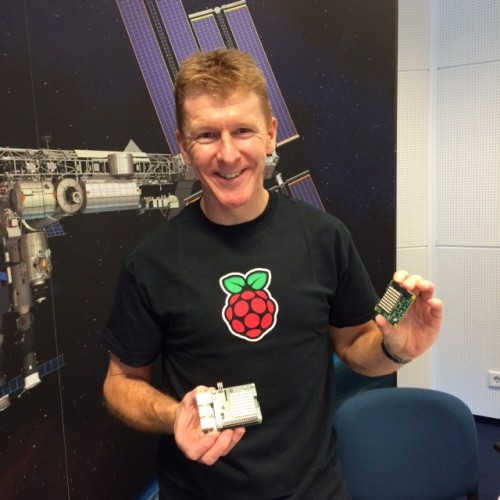
Image courtesy of ESA
Tim is going to get a rather awesome (and expensive) space grade aluminium case with heat dissipation fins, Velcro strips and support arm attachments for his Astro Pi. No you cannot buy this case, trust me it will be prohibitively expensive! What you’ll get is what you see in the pictures above. It will either be free as a reward for submitting a good primary or secondary school idea by the 3rd of April or, if you buy one, around £30 + delivery. There will be another announcement when they are on sale.
Below is a summary of the Astro Pi software and hardware. If you have any questions please comment below. We’re all standing by to answer you!
Python API
- Installable through PIP
- Provides effortless access to all of the hardware features below
- Full documentation will be available on GitHub
- Example code:
from sense_hat import SenseHat sense = SenseHat() sense.show_message("One small step for Pi!", text_colour=(255,0,0))This will just scroll the text One small step for Pi! on the LED matrix in red. (Code updated for new library name Jan 2016)
Note: The data sheet links below are only for those of you who really want that information, most humans don’t need to look at them at all!
I²C Sensors
- Inertial measurement sensor: ST LSM9DS1 (data sheet)
This is a 3D accelerometer, 3D gyroscope and 3D magnetometer combined in one chip. It will give you the pitch, roll and yaw orientation of the Astro Pi and therefore the ISS itself. It can also be used to detect when the ISS booster rockets are being fired or just as a compass to find the direction of North. - Barometric pressure and temperature sensor: ST LPS25H (data sheet)
This will give you a measurement of air pressure in Pascals or Millibars as well as the temperature in centigrade. - Relative humidity and temperature sensor: ST HTS221 (data sheet)
This gives you the percentage of relative humidity as well as the temperature in centigrade. The sensor is good enough to detect the water vapour in human breath so you could use it to detect the presence of the crew working near the Astro Pi.
Inputs
- PCB-mounted 5-button miniature joystick: Alps SKRHABE010 (data sheet)
Up, down, left, right and middle click. This will emulate the keyboard cursor keys and Enter for the middle click. Accessible via standard Linux event system /dev/input/event* - Additional GPIO push buttons will be accessible on the side of the aluminium flight case for functions such as controlled shut-down and reset. These will also be usable in your code via GPIO interrupt detection or polling. You are welcome to re-create them manually on your Astro Pi with any type of push button you have to hand.
- Standard Pi Camera Module (sensor data sheet)
- Pi NoIR Camera Module
Outputs
- 8×8 RGB LED matrix with ~60fps refresh rate and 15-bit colour resolution (RGB 5 5 5): Cree CLU6AFKW/CLX6AFKB (data sheet)
Accessible via frame buffer driver /dev/fb1 where each pixel is 16 bit (RGB 5 6 5). This is the only real form of visual output that the Astro Pi computers will have up on the ISS. For a number of technical and safety reasons we are not allowed to plug the HDMI or Composite outputs of the Raspberry Pi into anything on the ISS.
Micro controller
- A small MCU drives the LED matrix and scans for joystick input: Atmel ATTINY88 (data sheet)
It’s not the intention for this to be reprogrammable by the user.
For more information on the Astro Pi: Your Code in Space competition please visit astro-pi.org and click on How to Enter in the toolbar at the top.

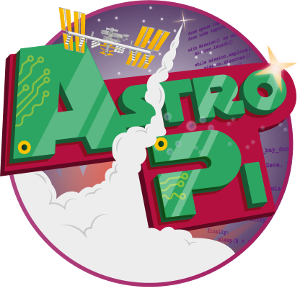
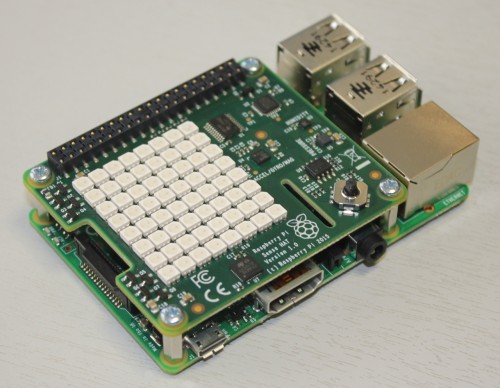
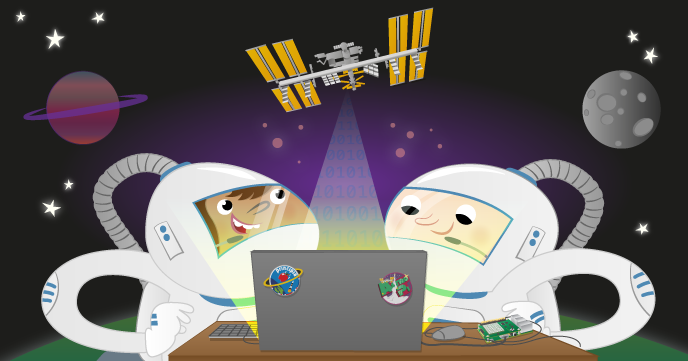
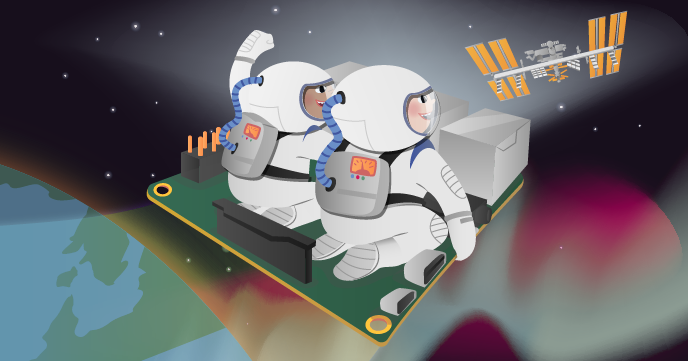


52 comments
Ewan
Is that two camera modules on one Pi? That would be new, wouldn’t it?
James Hughes
Not possible on the B+, so I expect this is because there are two Pi’s being launched.
Ben Nuttall
Correct – one Pi will have a normal camera module attached, the other a Pi NoIR.
David Honess — post author
There will be two Astro Pis available, one will have the standard visible spectrum camera and the other will have the Pi NoIR camera. So you can choose which one you want your code to run on.
Ben Nuttall
You can attach two cameras to a compute module! See Real time depth perception with the compute module
Ryan Osborn
Awesome. Do we have access to the interrupt pins on the LSM9DS1?
David Honess — post author
Not as far as I know it’s just on the I2C bus. I’ll double check though.
Ryan Osborn
Also, the spec sheet for the LSM9DS1 seems to suggest that it is using a left handed coordinate system for the accelerometer and the gyro, but a right handed coordinate system for the magnetometer. Is this correct?
David Honess — post author
The Python API will filter all this for you and provide everything as nice euler angles between zero and 360 degrees. The mag only gives one such angle, like yaw, which you can use like a compass.
tzj
Would it be able to measure intesity too or just direction?
Piotr
Where can I buy the Pi HAT?
David Honess — post author
It’s not available yet but you will be able to buy it from the Raspberry Pi swag store.
Dougie
Can you suggest a source (or at least the complete spec/datasheet) for those sensors for Earth based Raspberry Pis so that an experiment could be run in parallel one on the ground one on the ISS?
David Honess — post author
This is actually part of the mission. While Tim is up there, sometime between January and April 2016, he’ll not only run the code of the competition winners but he is going to do a few data logging deployments of the Astro Pi. The data from this will be available as a CSV file online and the idea will be that you replicate the same activity (on your own Astro Pi) and compare your data to his. If you’re after the data sheets there are links for them in the blog post above.
Alan McC
Going to be fantastic to find out what everyone’s ideas are.
What not to make perhaps : raspberry Pi HAL 9000 emulator – “Open the Pi Bay doors please HAL”…”I’m sorry Dave, I’m afraid I can’t do that” 2O15 an Astro-Pi Space Odyssey
Exciting times.
David Honess — post author
I think they’d get a kick out of that actually. You could make it look around like a beady eye :)
James Hughes
Any chance of sneaking a speaker into the case. I suspect playing some of the noises from Doom during sleep periods would make things exciting.
David Honess — post author
We had a great idea from a primary school where they wanted to get all the kids to record their best one line joke and they would be selected at random and played whenever a member of the crew floated by. We’re not flying a speaker with 3.5mm headphone jack but I’m sure they’ll have something like that up there already.
AndrewS
“In the video you see various computers and screens on the walls and it’s crazy to think that two Raspberry Pis will soon be there alongside them.”
Good thing that the Raspberry Pi is so small! :-)
“The sensor is good enough to detect the water vapour in human breath so you could use it to detect the presence of the crew working near the Astro Pi.”
I wonder if different astronauts would have different levels of water vapour in their breath?
David Honess — post author
Interesting experiment. Knowing who is who might be the issue. I think the level of water vapour you exhale changes throughout the day and will depend on how much water you’ve had.
James Hughes
How about a bad breath detector? Use the camera to photograph whoever is around when the sensor fires. I think its important we should know if our astronauts has bad mouth hygiene.
AndrewS
I’m suddenly reminded of http://www.raspberrypi.org/learning/fart-detector/
jbeale
I’m curious what “space grade aluminium” is and how it differs from more common alloys. I’ve seen R-Pi cases milled from solid metal, which were more expensive than the pi, but not necessarily ridiculous in price.
David Honess — post author
It’s going to be 6061 or 6063 grade aluminium with a lot of expensive tooling. There is a lot more detail than a normal Raspberry Pi case such as 5x5mm pins on the base for thermal transfer, support arm attachments which have a lot of detail, camera hole, joystick hole, LED matrix opening and Velcro loop holes. Four Alan key bolts in the corners and everything has to be beautifully smoothed off so that there is no possibility of a sharp edge.
AndrewS
Any details about which orientation the camera will be mounted in, relative to the Pi? On the side of the case, or pointing in the same direction as the LED matrix, etc. ?
David Honess — post author
Yeah the LED matrix is on the top in the normal HAT position but the camera faces out though the bottom of the case in the exact opposite direction. This way they can mount the Astro Pi on a bogen arm, aim the camera out of the Cupola window and still see the LED matrix from inside.
W. H. Heydt
Part of the requirements are probably things like deburring and cleaning to make sure that no dust (especially conductive dust) is shed, and that, after cleaning, there are no VoCs present. Not like you can just open a window and get rid of any noxious fumes.
AndrewS
LOL http://www.raspberrypi.org/astro-pi-tech-specs/#comment-1213148
sheroy
How does the compass/magnetometer work? Is the magnetic field of the earth sufficient? Or is it perturbed by the iss itself?
jdb
The magnetometer is sufficiently sensitive to pick up the Earth’s magnetic field at sea level with several bits of precision.
The ISS is mostly aluminium so shouldn’t have any impact on the incident magnetic field inside the modules.
Of course, local ferrous metals can distort the values returned by the sensor – which is one of the elements of the Astro-Pi competition – overcoming the inadequacy of the individual sensors by combining multiple sources of data.
Jarle
Can you simulate some functions / code with the Unicorn Hat ?? (Scrolling text) would a HAT be made available at any point to schools registered or would the school have to purchase one ??
Very excited to have coerced errrr sorry persuaded our school to enter competition ;0)
Jarle
Ahhhh just seen the ‘reward comment ‘ on top – would that include the Pi or just the HAT ??
David Honess — post author
It includes the Pi as well. Probably a Pi 2 actually.
Tom
Is the axis system for the inertial measurement sensor printed anywhere on the board? I can’t see it in the picture above. Knowing the axis system helps a lot when setting up and debugging IMU systems.
Ryan Osborn
It is in the datasheet linked in the post. It seems that it is using a left handed coordinate system for the accelerometer and gyro and a right handed coordinate system for the magnetometer
Szymon Życiński
My students were interested in participating but … all team members must be UK residents :/
Could you include in next projects students from at least EU?
jdb
Unfortunately the UK requirement isn’t imposed by us: it’s imposed by UKSA/ESA.
If there is enough of an audience across the EU for Astro-Pi (even if they aren’t participating) then a successor to Astro-Pi may be EU-wide.
condew
All those navigation sensors but nothing that moves. The space Pi needs a few fans, flywheels, or even flippers. Weightless and with air would be the coolest place to experiment with a drone; do nothing and it hovers; do anything and there is almost no friction to resist.
aremvee
In the previous post on the subject, I remember reading the actual Pi going up will be specially manufactured . So I imagine comments about the HDMI port and such are moot because they probably won’t be included in the first place?
Still wondering why then schools can be chuffed with pride that they have the same hardware in their hands. Maybe the same.
Clive Beale
You misremembered or misread as this is not the case. Schools can use exactly the same hardware: a B+ and an Astro Pi. http://astro-pi.org/hardware/#use-the-same-hardware-used-in-space
aremvee
thanks for that. i wonder where i got that impression. Pays to keep your words sweet in case you have to eat them
MP
Will the IMU be able to provide a roll / pitch yaw given that the local gravity will be very weak ?
Those units are not able of gyrocompassing to find the north, on finding the vertical rely very much on the acceleromters…
(at least when you are at usual altitudes with those kind of units)
If the gravity field is too weak, there is “no” reliable local vertical and therefore issues to define roll/pitch
Amelia
Hi!
So I’ve got into robotics but don’t know how to make my own robot! I would find it very helpful if you could post a video on how to make one I have looked all over for some videos but all of the equipment is from America so I can’t buy them please help me out!!!!
Thanks for reading :)
Clive Beale
http://www.raspberrypi.org/resources/
Jason
It would be great if data collected by the pi could be sent down to Earth in near real time and someone could write a program to pull that data from a central server so kids using RPi’s in the classroom could, in a way, have the astro pi sending info directly to their classroom pi’s.
ardupi.de
Is that a Intrernational competition????
AndrewS
Not this time.
http://www.raspberrypi.org/astro-pi-tech-specs/#comment-1213544
Dirk Broer
If I buy an AstroPi, can the accelerometer also be used for the Quake Catcher Network??
Clive Beale
BOINC and QCN run on the Pi, but no idea how the chip on the Sense board stacks up against the QCN sensors, either in terms of sensitivity and noise etc or just interfacing. Might want to ask on the forums. Would be a cheap solution if so (and they don’t appear to be handing out the sensors at the moment).
Jack Chaney
I am really, really excited about the prospect of having elementary and middle school aged people able to develop experiments to run on the ISS. Encouragement of fresh minds to push beyond normal limits is a goal to which, all educators should aspire. I would like to obtain an Astro Pi HAT, but am not an educator, and I have not seen information on them for the general public yet. I want to “play” too.
Raspberry Pi Staff Liz Upton
They will be available to the general public, but after the competition finishes. Watch this space!
Chris McKlveen
Is there an ETA when Astro Pi HAT will be available to the general public?
Thanks,